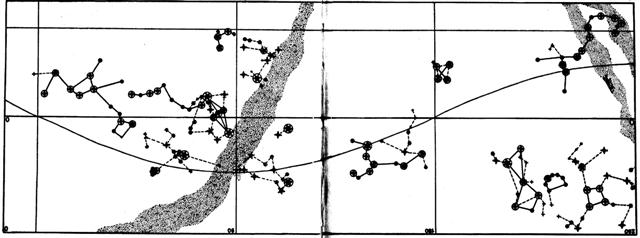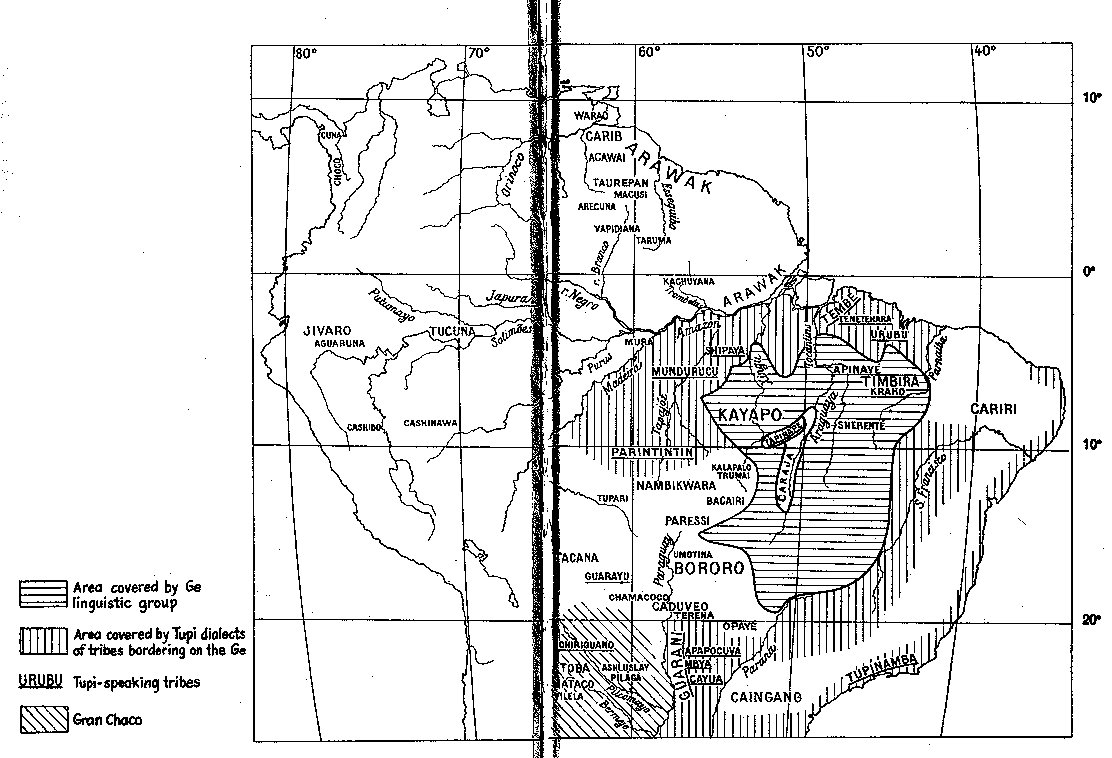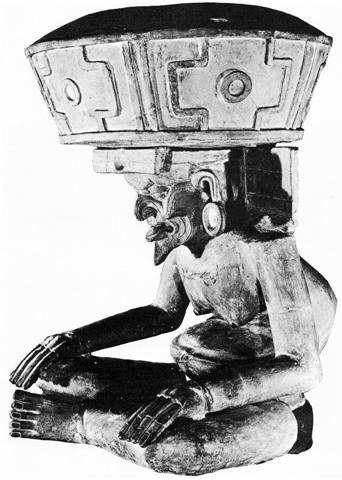|
TRANSLATIONS
The five otters may be the five planets, and if so they move in the (more or less) same path as sun and moon. There are 7 'wanderers' in the sky and they move as if on the surface of billowing water:
The celestial equator is the imaginary straight line crossing the (relatively) immobile stars, while the ecliptic describes a wave form over the seasons. "M21. Bororo. 'The origin of wild pigs' Day after day the men would go fishing and catch nothing. They would return to the village in a sad state of mind, not only because they were empty-handed, but also because their wives were sulking and gave them a poor welcome. The women even got to the point of challenging the men. They declared that they would do the fishing. But in actual fact all they did was to call on otters, who dived and fished in their stead. The women returned laden with fish, and each time the men tried to get their own back, they caught nothing. After a time the men suspected some sort of trick. They had the women spied on by a bird who revealed the truth. The next day, the men went to the river, called the otters, and strangled them one after another. Only one escaped. It was now the men's turn to jeer at the women, who caught nothing. The latter therefore determined to be avenged. They offered the men a drink made with special piqui fruits (Caryocar species), whose kernels they had left covered with spikes. 'The pikia ... bears a large edible fruit, curious in having a hollow chamber between the pulp and the kernel, beset with hard spines, which produce serious wounds if they enter the skin.' (Bates, p. 203) ... Choked by these spikes which stuck in their throats, the men grunted, 'u, u, u, u' and were changed into wild pigs that give this cry. (Colb. 3, pp. 259-60)." (The Raw and the Cooked) This is story about otters and men and women. That 'otters' fish by diving maybe is to be understood as that they sometimes go down into the 'water' as defined by the celestial equator. If so, then the 'surface of the water' is defined by the celestial equator (and not by the ecliptic). The otters (except one who escaped) were strangled by the men and I think about Oroi with his 'needle-sharp' weapon (equivalent to the pikia spikes): '... Oroi chooses neither the open fight nor the weapons of the honest warrior - the war club for close combat and the lance to fight from a distance. Instead, he sets a trap and intends to finish his assault with a thrust of a needle-sharp bone dagger ...' Also, Oroi was caught in a noose (which indicates strangling). And Oroi works in secrecy, hiding from view (like the moon at Ohiro): '... Oroi's posture on Easter Island is marked by secrecy and treachery. None of the sources describes him as a leader of warriors, and they all agree that his victims were defenseless children. Oroi lives in hiding and attacks only from behind ...' The tricks were played by the women: using otters to fish and not removing the spikes in the drink for the men. Woman means night and water and darkness - the female is crooked, while man means day and fire and light - the male is straight. Another myth: "M27. Bororo. 'The origin of tobacco' (2) Fishermen had settled themselves at the water's edge to grill their fish. One of them, with his knife, slit open the belly of a huddogo (an unidentified fish; Portuguese abotoado, EB, Vol. I, p. 748) and discovered tobacco inside. He hid the fish and smoked only at night, without telling his companions. The latter smelled the aroma and caught him at it. He then decided to share the tobacco with them. But the Indians swallowed the smoke instead of blowing it out. 'That is not the way to smoke', said the supernatural spirit who appeared in the guise of a vampire. 'First, puff, saying: Grandfather, receive the smoke and keep evil away from me! Otherwise, you will be punished because this tobacco belongs to me.' The Indians did not obey; therefore, by the following morning they had become almost blind and had been changed into ariranhas (*). This is why these animals have such small eyes. (Colb. 3, pp. 211-12.) * Ippié, ipie, in Bororo; in his translation of M21, Colbacchini renders the term as lontra 'otter', and he gives a curious definition of it is his glossary (p. 422): 'ariranha' um bichinho que fica a flor d'agua [? who lives on the face of the water]. Cf. Magalhães, p. 39, and EB, Vol. I, p. 64: ipié 'ariranha'. 'Ariranha' is the usual name for the giant otter (Pteroneura brasiliensis), which may be more than six feet in length; but in central and southern Brazil the term refers to the common otter ..." (The Raw and the Cooked) Once again fishing and secrecy in the night ('hid the fish and smoked only at night'); also other unsocial behaviour (not obeying). But in this myth the focus is different. Lévi-Strauss tries to explain: "... tobacco as playing a mediating role between earth and heaven; here the mediation is between earth and water (because of the Bororo belief that souls have a dwelling place in water). According to the Cariri myth, through acquiring an articulated skeleton men became truly human, and they can ensure that they are not cast off completely from the sky by making offerings accompanied by tobacco. The Bororo myth explains that because men refused to make offerings of tobacco, they ceased to be truly human and were changed into animals doomed to live 'on the surface of the water', and moreover blind: they were deprived of any 'opening' onto the external world, because of their excessive 'continence', which was expressed by the refusal to exhale tobacco smoke ..." To be human is to have an 'articulated skeleton' and to have fire. Both the 'skeleton' and fire are ultimately from the sky. According to the Bororo the souls dwelt in the water. There is a kind of logic in that because north of the equator the souls went up into the sky - south of the sky the same location means down in the water. To be changed into an otter (or pig) means to no longer be human, i.e. no longer to have fire (and perhaps also a body as flexible as that of a sneaky snake's). The eyes are connected with the fire. Down in the water the eyes are just 'watery' (as the Jaguar's), having no 'openings' onto the 'external' world. To be human is also to be social, to have 'openings' onto the 'external' world. But warriors (and Hotu Matua) must abstain from laughing (opening). The 'entrail snatcher 'cannot get at you unless you open up. Maybe this explains what M27 is about. But what has all this to do with rongorongo? Nothing. Everything. The Bororo belief in the souls of the dead as living in the 'water', presumably because the Bororo live south of the equator, may explain for instance why the night calendar has upside-down 'fishes'. The souls of the dead travel to the country of the dead far in the north and that means down in the 'water' when you have oriented yourself with face towards south (which then also becomes 'up').
The Bororo live at about the same latitude as Tiahuanaco and when we reflect on that fact it suddenly becomes clear why there are kingly bird heads hanging down at the ends of the two 'season staffs':
'Down' in Tiahuanaco probably meant the dark region in the north. But instead of having fish heads down in the deep they have kept the idea of north being the region of birds. The necessary adjustments after having crossed the equator may be fixed in different ways. It is therefore possible that the constellation Scorpio kept its dark image on Easter Island in spite of now being high up instead of down below. At the top of the left season staff we can see a semicircular sign which (due to its location just before midsummer) may represent the 'hill' of summer. The opposite sign would be the other part of a circle - like a cup (a female sign). When reading Egyptian hieroglyphs (according to their alphabetical values) we find the 'hill' sign denoting 't', i.e. the female ending (as in Rāt, the wife of Rā). The Tiahuanacuans have retained the symbol but used it in its male (apex of light) meaning. Why did the ancient Egyptians associate 't' (for female) with a hill? Is a hill a maximum of Mother Earth? We remember Ogotemmêli's words: ... The God Amma, it appeared, took a lump of clay, squeezed it in his hand and flung it from him, as he had done with the stars. The clay spread and fell on the north, which is the top, and from there stretched out to the south, which is the bottom, of the world, although the whole movement was horizontal. The earth lies flat, but the north is at the top. It extends east and west with separate members like a foetus in the womb. It is a body, that is to say, a thing with members branching out from a central mass. This body, lying flat, face upwards, in a line from north to south, is feminine. Its sexual organ is an anthill, and its clitoris a termite hill ... To take another example of what we may learn from the South American myths, and of possible use in understanding the rongorongo texts, the 'eyes' in the 'water' are inferior to the 'real eyes'. I suggest that the 'eyes' mean the 'organ of understanding'. 'I see' explains it. In darkness the eyes function poorly and in the murky waters eyes are rather useless. In the calendar of the week we have found Saturday to be devoid of light:
26 * 14 = 364 = the whole year with exception of the extracalendrical 1¼ 'dark' days, when 'the fires are put out'. The 'fire' is 'light' and the necessary medium for the 'eyes' (meaning 'understanding'). During extracalendrical nights (here we find it more appropriate to use the Polynesian word 'night' rather than 'day') there is no order, only confusion. 14 is half the period of 28 nights when the important moon delivers light during the otherwise dark period. 8 glyphs for Saturday presumably express a complete whole. Darkness is assembled in Saturday:
The 4th glyph (GD21, poporo) suggests the black colour for tattooing: '... This plant is - according to bishop Jaussen's documentations of what Metoro Tau'a Ure told him - one species of the interesting family of plants named Solanum. It was used for obtaining colour for tattooing. There are though several different variants of glyphs showing this plant, and possibly not all of these imply colour for tattooing. Every gift from nature was taken care of to the utmost. Barthel suggests the plant to be Solanum nigrum. As nigrum means black, the glyph perhaps was used for 'black'. Barthel points out that on the Marquesas they counted the fruits from the breadfruit trees in fours, perhaps thereby explaining the four 'berries' in this type of glyph. The breadfruit did not grow on Easter Island and the berries of Solanum nigrum were eaten in times of famine. Barthel also informs us that the Maori singers in New Zealand, where the breadfruit did not grow, 'translated' kuru (= breadfruit) in the old songs, from the times when their forefathers lived in a warmer climate, into poporo (= Solanum nigrum). Barthel further compares with the word koporo on Mangareva. The poor crop of breadfruits at the end of the harvest season was called mei-koporo, where mei stood for breadfruit. On other islands breadfruit was called kuru, except on the Marquesas which also used the word mei. Koporo was a species of nightshade. We may now, furthermore, propose that the bottom (5th) 'fruit' in the glyph is expressing the 'darkness at the bottom', i.e. Saturn. The other 4 planets ('berries') are higher located and therefore deliver more light (during the night) than Saturn. Saturn is the oldest fire and will therefore soon be completely finished (put out). Saturn means 'death'. But because of that it also has the responsability of giving new light (for next week). We should remember how Saturn gives the 'rule' to Jupiter, and the 'rule' means stability, order and understanding: '...Saturn does give the measures: this is the essential point. How are we to reconcile it with Saturn the First King, the ruler of the Golden Age who is now asleep at the outer confines of the world? The conflict is only apparent, as will be seen. For now it is essential to recognize that, whether one has to do with the Mesopotamian Saturn, Enki / Ea, or with Ptah of Egypt, he is the 'Lord of Measures' - spell it 'me' in Sumerian, 'parshu' in Akkadian, 'maat' in Egyptian. And the same goes for His Majesty, the Yellow Emperor of China - yellow, because the element earth belongs to Saturn - 'Huang-ti established everywhere the order for the sun, the moon and the stars'. The melody remains the same. It might help to understand the general idea, but particularly the lucubrations of Proclus, to have a look at the figure drawn by Kepler, which represents the moving triangle fabricated by 'Great Conjunctions', that is those of Saturn and Jupiter.
One of these points needs roughly 2.400 years to move through the whole zodiac ...' Saturn is the prime generator of 'light' because the old light is put out in Saturday. He gives the new light to Jupiter, a symbol for the earthly king. Such a ruler may be terrible: '... Wir übersetzen demnach 'Dāpinu' durch 'der schreckliche Helle'. Dieses Prädikat passt vorzüglich auf den Jupiter, ist aber vielleicht ursprünglich gar nich eine Bezeichnung dieses Planeten, sondern der Sonne und zwar der Frühsonne, die zum Jupiter in Beziehung gesetzt wurde. Völlig analog ist die Benennung Marduk's (der Frühsonne und des Planeten Jupiter) als der ūmu namru, d.i. des hellen Tages ...' From this we may associate to 'the old god at the centre', 'the lord of the present Sun', a 'fair' description of Saturn:
Xiuhtecuhtli, the fire god, as Huehueteotl, 'the old god at the centre'. One of the oldest deities of ancient America, this clay figure from the Veracruz culture shows him seated with a brazier on his head. Xiuhtecuhtli was lord of the present 'Sun', or era, his ceremonies being particularly important at the end of every fifty-two-year cycle when all fires were put out and a fresh one was kindled on a prisoner's breast in order to keep time moving ... |
|||||||||||||||||||||||||||||||












